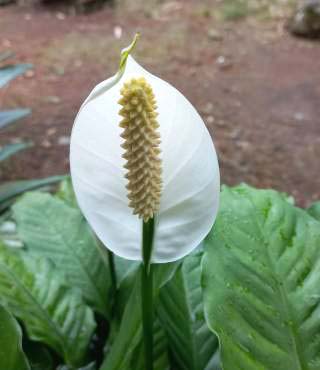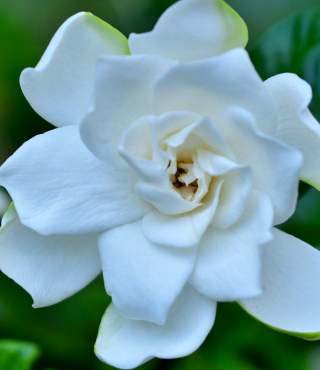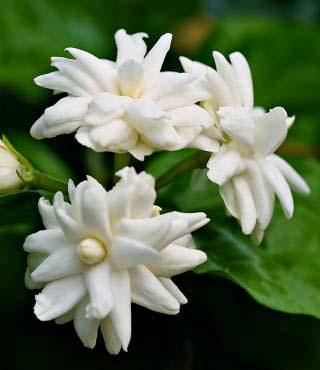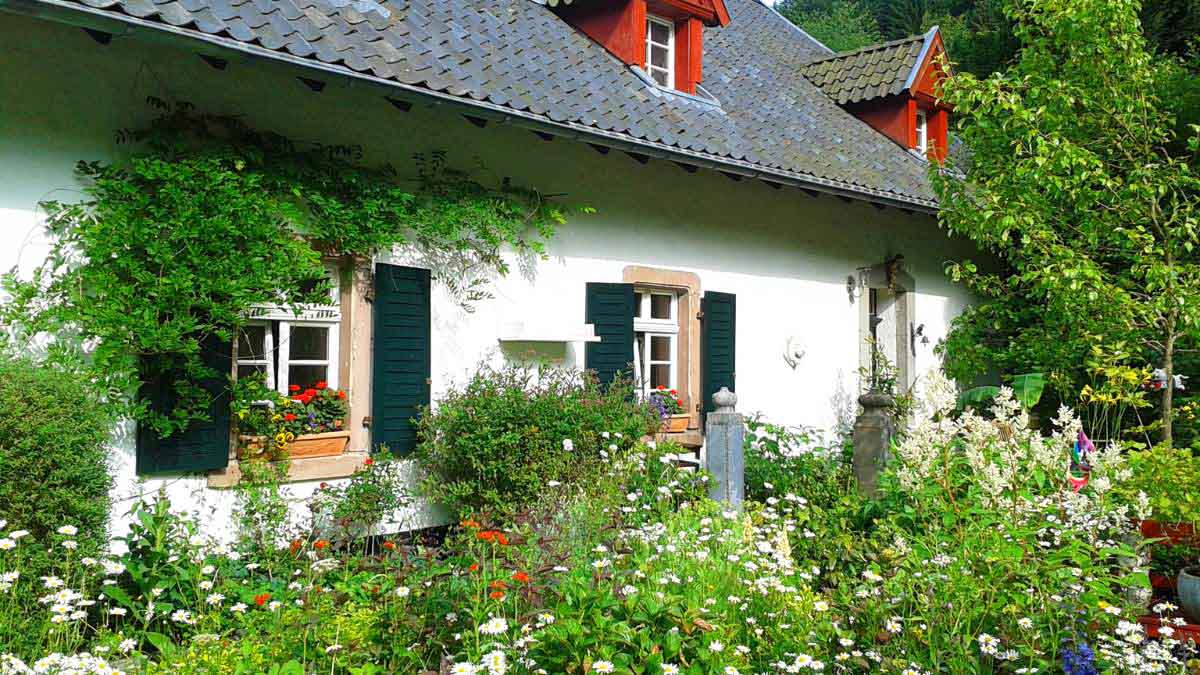House plants with white flowers include peace lilies, spider plants, and jasmine vines. These plants provide a touch of elegance and purity to any indoor space.
White flowers are known for their ability to brighten up a room and add a sense of tranquility. Whether you are looking to create a serene atmosphere or simply want to enhance your home’s aesthetic appeal, these plants are an excellent choice.
They are relatively low maintenance and can easily thrive in various lighting conditions. With their beautiful white flowers and lush green foliage, these house plants are sure to bring beauty and tranquility to your living space.
1. Peace Lily

The Peace Lily is a popular houseplant with elegant white flowers. It adds a touch of tranquility and beauty to any indoor space.
Peace Lily, scientifically known as Spathiphyllum, is a popular house plant with white flowers. Its elegant blooms not only add beauty to any space but also purify the air by removing harmful toxins. The Peace Lily is a versatile plant that thrives in both low light and bright indirect light conditions. It is an excellent choice for beginners as it requires minimal care and attention. To help you understand this captivating plant better, let’s delve into its description and characteristics.
Description And Characteristics
Peace Lily is a tropical perennial plant native to the rainforests of South America. Its shiny, dark green leaves stand in stark contrast to its delicate, white flowers, creating a stunning visual display. The flowers consist of a white spathe surrounding a protruding yellow and white spadix, giving it the appearance of a hooded cobra ready to strike. These flowers typically bloom during summer and can last for several weeks, adding a touch of elegance and serenity to any indoor space.
Besides its aesthetic appeal, the Peace Lily offers numerous benefits. Its rapid growth helps fill up empty corners quickly, making it a perfect choice for those looking to add a lush touch to their living environment. Additionally, this plant has been widely recognized for its air-purifying properties. It efficiently filters harmful toxins like formaldehyde, benzene, and carbon monoxide, helping create a healthier and cleaner indoor air.
Care Tips
Caring for a Peace Lily is relatively straightforward, making it an ideal companion for busy individuals or those new to plant ownership. Here are some essential care tips to keep your Peace Lily thriving:
1. Light: Peace Lilies thrive in bright, indirect light but can tolerate lower light conditions. Avoid placing them in direct sunlight as it can scorch their leaves.
2. Watering: Water your Peace Lily when the top inch of soil feels dry to the touch. Overwatering can lead to root rot, while underwatering can cause wilting. Striking the right balance is crucial.
3. Temperature and Humidity: This plant prefers average room temperatures between 65-85°F (18-29°C). It also thrives in higher humidity levels, making it an excellent choice for bathrooms or kitchens.
4. Fertilization: Feed your Peace Lily with a balanced, water-soluble fertilizer once a month during the growing season (spring and summer). It is recommended to dilute the fertilizer to half strength, as overfertilizing can have adverse effects.
5. Repotting: As Peace Lilies are known to be fast growers, repotting them every 1-2 years is recommended. Use a well-draining potting mix and choose a pot slightly larger than its current one.
Remember to keep an eye out for common pests such as scale, mealybugs, and spider mites. Regularly wiping the leaves with a damp cloth helps prevent dust buildup and keeps them looking vibrant. With these care tips in mind, you can enjoy the beauty of your Peace Lily for years to come.
Overall, Peace Lily is a remarkable plant that not only adds elegance to your indoor space but also supports clean and healthy air. Its unique white flowers, along with its low-maintenance nature, make it an excellent choice for plant enthusiasts of all levels. Whether you’re a beginner or an experienced plant lover, this captivating plant is sure to bring serenity and beauty to your home or office.
2. Orchids

Orchids are renowned for their exquisite beauty and delicate charm, making them a coveted choice for indoor gardens. With their stunning array of white flowers, orchids can effortlessly brighten up any space. Let’s dive into the fascinating world of orchids and explore their unique characteristics and care tips.
Description And Characteristics
Orchids belong to the Orchidaceae family, one of the largest families of flowering plants. These elegant beauties are known for their intricate patterns, vibrant colors, and distinct fragrances. Orchids with white flowers evoke a sense of purity and elegance. Their pristine blooms can range in size from small and delicate to large and showy. Whether it’s the classic white Phalaenopsis or the exotic Cattleya, there’s an orchid with white flowers to suit every taste and style.
One unique characteristic of orchids is their diverse range of flower shapes. Some orchids have blooms that resemble butterflies, while others bear resemblance to delicate swans. Many orchid varieties produce multiple flowers on a single stem, creating a spectacular display. These fascinating plants have also adapted to various environments, including tropical rainforests, mountainous regions, and even deserts.
Care Tips
Caring for orchids with white flowers requires a delicate touch, but with the right knowledge, anyone can enjoy their beauty at home. Here are some essential care tips to keep in mind:
- Light: Orchids prefer bright, indirect light. Place them near a window where they can receive filtered sunlight. Avoid exposing them to direct sunlight.
- Temperature and Humidity: Orchids thrive in temperatures ranging between 60°F and 80°F (15°C to 27°C). They appreciate higher humidity levels, so misting their leaves periodically or placing a tray filled with water nearby can help create a humid environment.
- Watering: Orchids have unique watering needs. It’s best to water them early in the morning, allowing the roots to dry before nightfall. Ensure proper drainage to prevent waterlogging, as orchid roots are susceptible to rot.
- Fertilization: Orchids benefit from regular fertilization during their active growth period. Use a balanced orchid fertilizer according to the instructions provided, usually every two to four weeks. Be careful not to over-fertilize, as this can damage the delicate roots.
- Potting and Repotting: Orchids require specific potting mediums, such as special orchid bark or moss, to encourage proper drainage. Repotting should be done when the plant outgrows its current pot or the potting medium breaks down, usually every one to two years.
With these care tips in mind, you’ll be well-equipped to provide a thriving environment for your orchids with white flowers. Remember, patience is key when it comes to orchids, as they may take time to bloom and require consistent care. Embrace the beauty and elegance these stunning plants bring to your indoor garden.
3. Gardenia

Gardenia is a popular house plant choice for those seeking white flowers. Its delicate blooms add elegance and a touch of freshness to any indoor space. With proper care and attention, Gardenia can thrive and bring beauty to your home.
Beloved for its stunning beauty and exquisite fragrance, the Gardenia is a popular choice among houseplant enthusiasts. With its elegantly shaped white flowers, this plant adds a touch of elegance and serenity to any indoor space.
The Gardenia, scientifically known as Gardenia jasminoides, is native to tropical and subtropical regions, such as Africa, Asia, and the Pacific Islands. It belongs to the family Rubiaceae and is also referred to as the Cape Jasmine. This evergreen shrub boasts glossy, dark green leaves and produces large, showy flowers that exude a sweet, intoxicating scent.
While the Gardenia may seem delicate, it can thrive indoors with proper care and attention. Here are some valuable tips to ensure your Gardenia flourishes:
- Light: Gardenias require bright, indirect light to thrive. Place them near a south or west-facing window where they can receive ample sunlight, but avoid direct exposure to intense midday sun to prevent leaf burn.
- Temperature: Maintain a warm environment for your Gardenia, ideally between 65-70°F (18-21°C) during the day and slightly cooler at night. Avoid exposing it to drastic temperature fluctuations.
- Humidity: These plants love humidity, so increase the moisture level in the air by using a humidifier or placing the pot on a tray filled with water and pebbles. Misting the leaves regularly can also help simulate their natural habitat.
- Watering: Keep the soil consistently moist, but not waterlogged. It’s crucial to strike the right balance, as both underwatering and overwatering can cause the plant to suffer. Check the soil regularly and water when the top inch feels dry, ensuring the water drains properly.
- Fertilization: Feed your Gardenia with a balanced, water-soluble fertilizer formulated specifically for acid-loving plants. Apply it according to the package instructions, usually every two to four weeks during the growing season.
- Pruning: Prune your Gardenia after flowering to maintain its shape and encourage new growth. Remove any dead or yellowing leaves, and trim back long, straggly stems. Pruning in early spring is ideal.
- Pest Control: Keep an eye out for common houseplant pests, such as aphids, mealybugs, and scale insects. If you spot any, take immediate action to control the infestation using organic methods or insecticidal soap, being careful to follow the instructions.
By following these care tips, your Gardenia will reward you with its graceful presence and heavenly fragrance. Remember, this plant requires patience and careful attention, but the beauty it brings to your home makes it all worthwhile.
4. Jasmine

Looking for a house plant with beautiful white flowers? Jasmine is the perfect choice! This fragrant and elegant plant will add a touch of sophistication to any space. In this section, we’ll explore the description, characteristics, and care tips for Jasmine.
Description And Characteristics
Jasmine, belonging to the Oleaceae family, is a popular indoor plant known for its delicate white flowers and captivating scent. The flowers typically have five or six petals and emit a sweet aroma that fills the room with a soothing ambiance.
These ornamental plants are native to tropical and subtropical regions, thriving in places with warm temperatures and high humidity. Jasmine can be grown in pots or hanging baskets, making it a versatile choice for indoor gardening.
One of the most well-known varieties of Jasmine is Jasminum polyanthum, commonly referred to as Pink Jasmine or Chinese Jasmine. It is recognized for its abundance of small, star-shaped flowers that bloom in clusters, creating a stunning visual display.
Care Tips
To keep your Jasmine plant healthy and blooming, here are some essential care tips to follow:
- Light: Jasmine plants thrive in bright, indirect light. Place them near a sunny window or provide supplemental lighting if necessary.
- Temperature: Maintain a moderate temperature range of around 60°F to 75°F (15°C to 24°C) for optimal growth.
- Watering: Jasmine plants prefer slightly moist soil. Water them thoroughly when the top inch of soil feels dry, but avoid overwatering, as it can lead to root rot.
- Humidity: Due to their tropical origins, Jasmine plants appreciate high humidity levels. Mist the leaves regularly or use a humidifier to create a favorable environment.
- Fertilizer: Feed your Jasmine plant once a month during the growing season with a balanced liquid fertilizer diluted to half strength.
- Pruning: Prune your Jasmine plant regularly to maintain its shape and promote healthy growth. Trim back any dead or damaged branches and pinch off faded flowers to encourage new blossoms.
- Pests: Monitor your Jasmine plant for common pests such as aphids or spider mites. If detected, treat the infestation promptly with organic insecticides or insecticidal soap.
- Safety Precautions: Keep in mind that Jasmine plants are toxic to pets if ingested. Take precautionary measures to ensure they are out of reach of curious animals.
By following these care tips, your Jasmine plant will thrive and reward you with a continuous display of its exquisite white flowers and enchanting fragrance. It’s time to bring the beauty of Jasmine into your home!
5. Stephanotis

Stephanotis, also known as Madagascar jasmine, is a beautiful house plant that boasts stunning white flowers. With its delicate aroma and elegant appearance, this flowering plant is a popular choice among plant enthusiasts.
Description And Characteristics
Stephanotis plants are native to Madagascar and belong to the family Apocynaceae. These evergreen climbers can reach impressive heights, with some varieties growing up to 20 feet tall. The leaves of the Stephanotis plant are shiny and dark green, creating a lush backdrop for its exquisite white flowers.
The most prominent feature of the Stephanotis plant is its stunning white flowers, which resemble small, star-shaped blooms. These fragrant flowers typically measure around 2 inches in diameter and are arranged in clusters. The captivating combination of glossy leaves and fragrant blossoms makes the Stephanotis an eye-catching addition to any indoor space.
Care Tips
Proper care is essential to keep your Stephanotis plant healthy and flourishing. Here are some care tips to help you create an ideal environment for this stunning house plant:
- Light: Place your Stephanotis plant in a spot that receives bright, indirect sunlight. Avoid exposing it to direct sunlight as it can scorch the leaves.
- Temperature: Stephanotis plants thrive in temperatures between 65°F and 75°F (18°C and 24°C). Avoid placing them near drafty windows or areas with extreme temperature fluctuations.
- Watering: Keep the soil consistently moist but not waterlogged. Water the plant thoroughly whenever the top inch of soil feels dry to the touch. Ensure proper drainage to prevent waterlogging, which can lead to root rot.
- Fertilization: Feed your Stephanotis plant with a balanced, water-soluble fertilizer once a month during the growing season (spring and summer). Follow the instructions on the fertilizer packaging for the appropriate dosage.
- Pruning: Prune your Stephanotis plant regularly to maintain its shape and promote healthy growth. Trim off any dead or yellowing leaves, as well as spent flowers, to encourage new blooms.
- Support: As a climbing plant, Stephanotis requires support to grow properly. Consider providing a trellis, stake, or plant support to help it climb and maintain an upright form.
By following these care tips, you can ensure that your Stephanotis plant thrives and blesses your home with its remarkable white flowers and enticing fragrance. Don’t hesitate to add this exquisite beauty to your indoor plant collection!
Frequently Asked Questions For House Plants With White Flowers
What Indoor Plant Has White Flowers?
Peace lilies are a popular indoor plant with elegant white flowers.
What Is The Plant With White Flowers Called?
The plant with white flowers is commonly known as a white-flowered plant.
What Is A Green House Plant With White Flowers?
One green house plant with white flowers is the peace lily. It is a popular choice for indoor gardening.
What Is A Highly Scented Indoor Plant With White Flowers?
The highly scented indoor plant with white flowers is called Gardenia jasminoides.
Conclusion
House plants with white flowers not only bring beauty and elegance to any space but also offer a sense of serenity and tranquility. From the delicate blooms of peace lilies to the fragrant blossoms of gardenias, these plants provide a refreshing touch of nature indoors.
Whether you’re a seasoned plant lover or a beginner, incorporating plants with white flowers into your home can uplift your mood and improve the quality of your living environment. So go ahead and add a touch of natural beauty to your space with these stunning white-flowering house plants.




